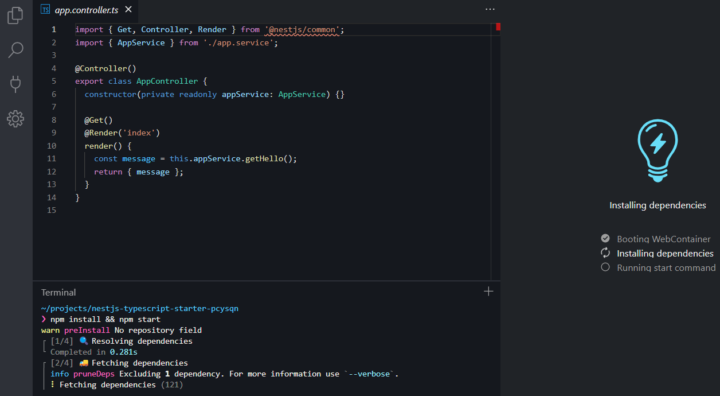In today’s interconnected global economy web applications and eCommerce sites have become a mainstay for many organizations. It comes as no surprise then that web application frameworks that can automate transactions through APIs are extremely popular. Some frameworks focus on client-side functionality and others, like Nest JS, for example, focus on server-side applications.
Because developers have so many choices when it comes to web application frameworks. Having an integrated development environment that is natively compatible with the chosen web application framework, will greatly increase the speed and accuracy of the development of web application server-side components. Cutting down on the time spent on repetitive development tasks.
Introducing Nest JS

Nest JS is a web application framework for creating scalable, efficient Node.js server-side applications. It employs progressive JavaScript, is designed using and fully supports the object-oriented variant of JavaScript, TypeScript, and allows developers to write code in pure JavaScript too. Nest JS blends the features of Object-Oriented Programming, Functional Programming, as well as Functional Reactive Programming.
Nest JS exposes the APIs of various HTTP server frameworks directly to the developer by offering a degree of abstraction over most common Node.js frameworks, such as Express and Fastify. This allows developers to take advantage of the plethora of third-party modules available from the underlying platform.
Drawing its inspiration from the Angular web application framework, Nest JS provides an out-of-the-box application architecture that enables web developers to build applications that are fully testable, flexible, loosely linked, and easily maintained.
What does Nest JS consist of?
Nest JS can be divided into the following core components: Controllers, Modules, and Services.
Controllers oversee and deal with incoming requests and react to client-side requests. Modules are available so that developers can structure and separate their code into smaller reusable blocks. By removing the complex logic away from the user, the services provide the ability to inject a service directly into controllers and other supported application services.
Benefits of utilizing Nest JS
Nest JS has proven itself to be highly modular, having the flexibility of utilizing any of the libraries that it is paired with. This is especially useful because web applications must often utilize various environments. Depending on the implementation, often, various configurations are used. Nest JS provides a native configuration package to deal with this requirement easily and efficiently.
Due to its versatility, Nest JS is capable of being utilized as an extensible environment that can serve as a solid foundation for all types of server-side applications. It can integrate with various technologies like Mongoose, GraphQL, Validation, and WebSockets to name but a few.
Web applications need to be highly adaptable and compatible with changes to client needs without having to rewrite entire application server-side utilities. Nest JS can adapt and utilize the latest JavaScript updates and features. Providing developers with a stable, mature, server-side Node JS solution.
Nest JS also boasts a powerful command line interface, which allows developers precise control over testing, boosting efficacy and ease of development. Nest JS also utilizes TypeScript which makes it extremely compatible with any typed language based on JavaScript.
Nest JS Vs. Next JS
 The Next.js web application framework enables developers to create applications that scale with minimum configuration and a tiny footprint. Next JS configuration is constructed as a single index.js file that does the initial configuration, slimming down the application considerably.
The Next.js web application framework enables developers to create applications that scale with minimum configuration and a tiny footprint. Next JS configuration is constructed as a single index.js file that does the initial configuration, slimming down the application considerably.
Nest JS, on the other hand, is more modular. However, by simply installing the packages that are required, a lower footprint can be accomplished. Nest JS supports more sophisticated server-side functions, such as intelligent routing. Nest JS, which is built on a data-driven approach to web applications, can also help with the acquisition of external data pieces.
To Summarise
Overall, developers that opt to use NestJS will undoubtedly have a competitive advantage. Nest JS allows developers to get started quickly by installing it and launching a new application. Nest JS can be ready for use in a matter of minutes, giving development teams a major edge.
With extensive documentation available online, the learning curve of Nest JS is also greatly reduced. Nest JS will eventually help development teams correctly plan and manage their projects, increasing the longevity and scalability of their web applications.

















